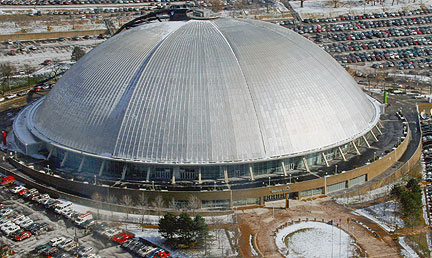
On the Decision Regarding the Civic Arena by the Sports & Exhibition Authority
PHLF News
October 1, 2010
We at Pittsburgh History & Landmarks Foundation regret the potential loss of the Civic Arena as a unique example of early modernism in American architecture. 
Conceived by philanthropist Edgar J. Kaufmann, Sr. and funded as an innovative public-private partnership, the project was intended to be a grand contribution to the region––a “civic” auditorium and convention center. Mitchell & Ritchey, the premier Pittsburgh architectural firm during the city’s Renaissance, designed the Arena in 1954; it was completed in altered form in 1961. It was a daring, contemporary design and an extraordinary feat of engineering with the world’s largest retractable roof.
However, we also understand the practical difficulty of saving and finding a feasible use for it that will generate sufficient revenue to adapt and to maintain it. We also recognize that the local constituency in the Hill District and others who in the 1960s opposed the demolition of the Lower Hill for the development of the then-styled “Arts Acropolis” have negative feelings about the existence of the Arena, which caused the taking and demolition of many houses and businesses.
Early in the study period, we looked at the possibility of saving the steel structure that holds the leaves in place, together with retaining several of the leaves underneath, so as to project what the Arena originally was and to serve as a sculpture in the landscape. Unfortunately, because of the amount of land area that would be taken permanently for such a monument, the streets running from the Hill District to the City could not be reestablished with concomitant development. Considerable future maintenance costs would also be entailed.
We also recognize the financial problems of the City and the fact that it lacks revenue to sustain the infrastructure, buildings and green spaces that it already has, and that it cannot become the fiscal custodian of another major public place.
If time can be given to further study alternative uses for the Arena, as Senator James Ferlo has suggested, we would support that. However, there need to be feasible proposals that appear to warrant serious study.
From the outset of the discussions, we have advocated that Section 106 of the National Historic Preservation Act, and not just the State History Code, be followed by the Sports & Exhibition Authority (SEA). The Section 106 review process requires that alternatives be evaluated “that could avoid, minimize or mitigate adverse effects on historic properties,” and we understand that the SEA feels that the report by Michael Baker does that. The report, however, fulfills only part of the requirements and processes that are clearly defined in the Section 106 regulations.
We believe there is the possibility of jeopardizing the future use of federal funds for the redevelopment of the entire 28-acre Lower Hill site if Section 106 is not complied with prior to the demolition of the Arena. Section 110(K) of the National Historic Preservation Act prohibits “anticipatory demolitions” by placing a penalty on applicants of federal funds, including local governments, that intentionally destroy or harm historic properties prior to the completion of the Section 106 review process. The National Trust for Historic Preservation, our organization, and others have informed the SEA that proceeding with the demolition of the Arena may jeopardize the future use of federal funds at the site and make the federal funds vulnerable to legal challenge.
The Hill District is now engaged in a master planning process. The Penguins have provided a plan to establish a street grid reuniting the Lower Hill with downtown, including a connection over the Crosstown Expressway, and to create opportunities for major development. The land will be returned to the tax roles and enormous development opportunities, particularly for housing, will present themselves.
The Arena issue is a difficult one for all of us in the preservation community. Those who opposed the original urban renewal plan to demolish the Lower Hill and erect the Arena find themselves with the choice of trying to save the Arena or endorsing a plan that calls for the establishment of an urban street grid along with new development that supports the Hill District community’s desire to develop a plan that reunites the Hill District with the City.
This is not the first time that our community has had to deal with such an issue, nor will it be the last. Urban renewal of the 1960s deprived us of significant buildings, familiar street grids, and landscapes to be replaced by structures that at the time were generally not felt by preservationists to be equal in design quality to what was being lost. We hope that further discussion regarding the Arena and each related project will be conducted with objectivity and civility.
In the case of the Arena, we would favor its preservation if a practical plan were to be put forth that did not add to the financial burden of the City, that generated tax revenues from the land in the Lower Hill and development opportunities as well, and was supported by the Hill District residents.
If the Arena is to be removed, we then support the plan to establish an urban street grid, opening the land to provide development opportunities to a variety of developers, and we will suggest that a high standard of contemporary design be required.
